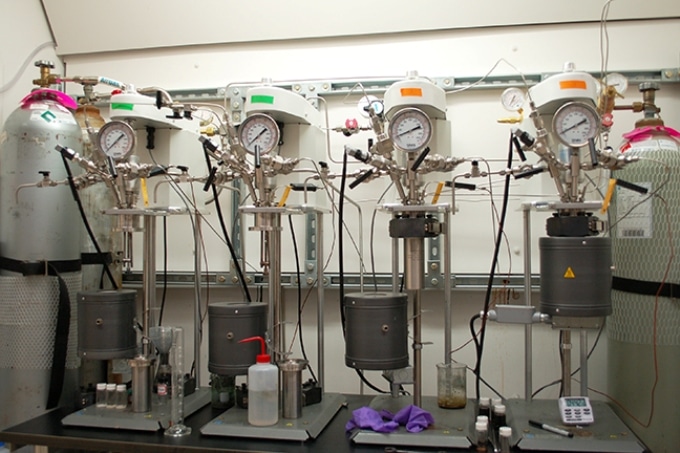Feb 9 2017
A research team headed by the University of Minnesota has invented a new technology that will help develop automobile tires from grasses and trees in a process capable of shifting the tire production industry toward using renewable resources available in our backyards.
 Catalytic conversion of biomass-derived chemicals to renewable polymers occurs in laboratory stirred-tank reactors. Credit: University of Minnesota
Catalytic conversion of biomass-derived chemicals to renewable polymers occurs in laboratory stirred-tank reactors. Credit: University of Minnesota
Traditional car tires are considered to be environmentally unfriendly as they are predominately produced from fossil fuels. The car tires developed from biomass that that includes trees and grasses would be identical to the currently available car tires with the same performance, shape, color, and chemical makeup.
The University of Minnesota has patented this new technology, which is currently available for licensing through the University of Minnesota Office of Technology Commercialization.
ACS Catalysis, the American Chemical Society’s leading journal in the chemical and catalysis sciences, has published this new study. The study’s authors include researchers from the University of Minnesota, University of Massachusetts Amherst, and the Center for Sustainable Polymers, a National Science Foundation-funded center at the University of Minnesota.
“Our team created a new chemical process to make isoprene, the key molecule in car tires, from natural products like trees, grasses, or corn,” stated Paul Dauenhauer, a University of Minnesota associate professor of chemical engineering and materials science and lead researcher of the study. “This research could have a major impact on the multi-billion dollar automobile tires industry.”
“Collaboration was really the key to this research taking biomass all the way to isoprene,” said Carol Bessel, the deputy director for the chemistry division at the National Science Foundation (NSF), which funds the Center for Sustainable Polymers. “This collaboration and synergy among researchers with different approaches and skills is really what we are trying to promote within the NSF Centers for Chemical Innovation Program.”
Isoprene is currently developed by thermally breaking apart molecules present in petroleum that are more like gasoline in a process called “cracking.” This is followed by separating the isoprene from an increasing number of products and then purified. Finally, the isoprene is made to react with itself into long chains in order to produce a solid polymer that is the key component in car tires.
For the past decade, biomass-derived isoprene has been a significant initiative of tire companies with immense effort focused on fermentation technology, which is similar to the production of ethanol. However, it has been established that renewable isoprene is a complex molecule to generate from microbes, and efforts to develop it by a complete biological process have failed to be successful.
This study has been funded by NSF and researchers from the Center for Sustainable Polymers have concentrated on a new process that commences with sugars obtained from biomass including corn, trees and grasses. The researchers discovered that optimization for a three-step process takes place when it is “hybridized,” also meaning that it includes biological fermentation using microbes with standard catalytic refining that is much like the petroleum refining technology.
Microbial fermentation of sugars, such as glucose, obtained from biomass to an intermediate, called itaconic acid, is the first step of the new process. The itaconic acid is made to react with hydrogen to a chemical called methyl-THF (tetrahydrofuran) in the second step. Optimization of this step took place when the researchers identified a unique metal-metal combination that was considered to be a majorly efficient catalyst.
The breakthrough of this process technology occurred in the third step to dehydrate methyl-THF to isoprene. The team demonstrated a catalytic efficiency as high as 90%, with most of the catalytic product being isoprene, by using Phosphorous Self-Pillared Pentasil (P-SPP), which is a catalyst recently discovered at the University of Minnesota. It is possible to renewably source isoprene from biomass by combining all three steps into a process.
“The performance of the new P-containing zeolite catalysts such as S-PPP was surprising,” says Dauenhauer. “This new class of solid acid catalysts exhibits dramatically improved catalytic efficiency and is the reason renewable isoprene is possible.”
“Economically bio-sourced isoprene has the potential to expand domestic production of car tires by using renewable, readily available resources instead of fossil fuels,” said Frank Bates, a world-renowned polymer expert and University of Minnesota Regents Professor of Chemical Engineering and Materials Science. “This discovery could also impact many other technologically advanced rubber-based products.”
Besides Professor Dauenhauer, the other researchers who were part of the study from the University of Minnesota were professors Michael Tsapatsis and Kechun Zhang, postdoctoral researchers Omar Abdelrahman, Dae Sung Park, Charles Spanjers and Limin Ren, and current student Katherine Vinter. Also part of the research team were professor Wei Fan and student Hong Je Cho from the University of Massachusetts.
The full research paper entitled “Renewable Isoprene by Sequential Hydrogenation of Itaconic Acid and Dehydra-Decyclization of 3-Methyl-Tetrahydrofuran,” is available online.
The invention of renewable tire technology is part of a bigger mission of the Center for Sustainable Polymers, an NSF-funded Center for Chemical Innovation headed by the University of Minnesota. The CSP, initiated in 2009, has concentrated on transforming how plastics are made and unmade through ground-breaking research. Researchers are focusing on the design, preparation and implementation of polymers generated from renewable resources for a variety of enhanced applications.